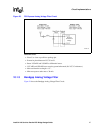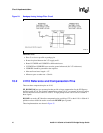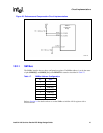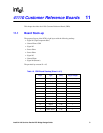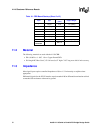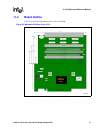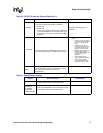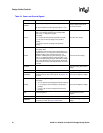
Intel® 41110 Serial to Parallel PCI Bridge Design Guide 57
Design Guide Checklist
A_M66EN
Controls frequency of the PCI segment when running
in conventional PCI mode (33 MHz or 66 MHz):
0 = 33 MHz PCI
1 = 66 MHz PCI
• Pull-up using a 8.2KΩ resistor when the PCI bus is
to operate at 66 MHz and not already pulled up by
system board. This signal is grounded for 33 MHz
operation.
Sampled on the rising edge of
PERST#.
A_PCIXCAP
Connects directly to the PCIXCAP pin on the PCI slot.
Connect to VCC33 through an 8.2KΩ pullup resistor.
• Design without secondary PCI/PCI-
X Slot
— If there is at least one legacy
PCI device on the PCI/PCI-X
bus, tie this pin directly to
GND.
— If all devices are PCI-X
capable and there is at least
one PCI-X device that only
supports maximum PCI-X
66MHz on the secondary PCI
bus, pull down to GND
through 10K
Ω series resistor
parallel with a 0.01uF
capacitor.
— If all secondary PCI-X
devices (and the bus loading)
support PCI-X 133MHz,
connect PCIXCAP to 3.3V
through an 8.2K
Ω resistor
IDSEL
The series resistor on IDSEL should be 200Ω ±5% if it
is exclusively PCIX mode. If it is PCI mode or mixed
PCI/ PCIX mode is intended, 510 ohms is
recommended.
Table 21. Miscellaneous Signals
Signals Recommendations Reason/Impact
RSTIN#
Used for debug purposes. Connect to VCC33 through
an 8.2KΩ pullup resistor for normal operation.
A_STRAP0,
A_STRAP1,
A_STRAP2,
A_STRAP6,
RESERVED [8:1]
These signals REQUIRE external pull-downs to GND
on the board 8.2KΩ unless otherwise stated.
Table 20. PCI/PCI-X Interface Signals (Sheet 2 of 2)
Signals Recommendations Reason/Impact



